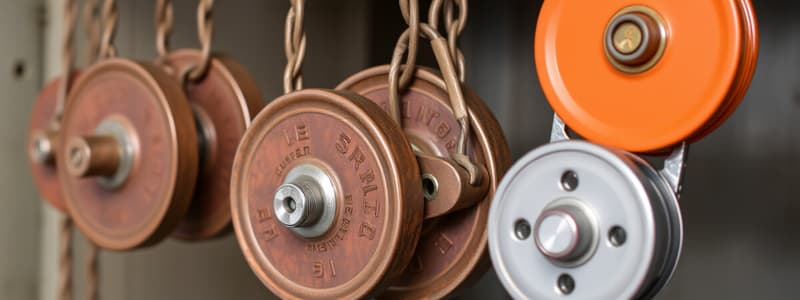Podcast
Questions and Answers
What are pulleys and how do pulleys help us?
What are pulleys and how do pulleys help us?
Pulleys are simple machines that give us a mechanical advantage.
What is the advantage of a single fixed pulley?
What is the advantage of a single fixed pulley?
The advantage of a single fixed pulley is 1 to 1.
What is the advantage of a single movable pulley?
What is the advantage of a single movable pulley?
The advantage of a single movable pulley is 2 to 1.
What is a mechanical advantage?
What is a mechanical advantage?
What happens when you increase the number of pulleys used to lift a load?
What happens when you increase the number of pulleys used to lift a load?
Name examples of a class 1 lever.
Name examples of a class 1 lever.
Name examples of a class 2 lever.
Name examples of a class 2 lever.
Name examples of a class 3 lever.
Name examples of a class 3 lever.
What are the four parts of a lever?
What are the four parts of a lever?
What is an inclined plane, and how does it give a mechanical advantage?
What is an inclined plane, and how does it give a mechanical advantage?
What is a lever?
What is a lever?
What is force?
What is force?
What is motion?
What is motion?
What is distance?
What is distance?
What is a fulcrum?
What is a fulcrum?
What is work?
What is work?
Flashcards are hidden until you start studying
Study Notes
Pulleys and Mechanical Advantage
- Pulleys are simple machines that provide mechanical advantage, making it easier to lift heavy loads.
- A single fixed pulley offers a mechanical advantage of 1:1, meaning the force needed to lift an object equals the object's weight.
- A single movable pulley has a mechanical advantage of 2:1, requiring half the force to lift an object, while also needing twice the rope length to lift the load.
- Mechanical advantage refers to the assistance a machine provides to complete work more efficiently.
- Increasing the number of pulleys used reduces the effort needed to lift loads, enhancing their effectiveness.
Levers
- Class 1 levers have the fulcrum between the effort and load; examples include teeter-totters, oars, catapults, and scissors.
- Class 2 levers have the load between the effort and fulcrum; examples include wheelbarrows, crowbars, and human joints like arms.
- Class 3 levers place the effort between the load and fulcrum; examples include brooms, bats, and fishing rods.
- The four essential parts of a lever are the load, effort, lever or beam, and fulcrum.
Other Simple Machines
- An inclined plane is a ramp designed to help move heavy objects up or down heights, offering mechanical advantage through gradual elevation changes.
- Levers increase force; they function by allowing a long stick to pivot on a fulcrum to move another object.
Fundamental Concepts
- Force is calculated using the formula F = ma (mass times acceleration).
- Motion refers to the changing position or location of an object.
- Distance measures how far an object has traveled from its starting point or how far it is from another object.
- A fulcrum is the pivotal point on which a lever rests and pivots.
- Work is defined as the energy spent in applying a force to move an object, calculated with the formula W = F × D (work = force times distance).
Studying That Suits You
Use AI to generate personalized quizzes and flashcards to suit your learning preferences.




